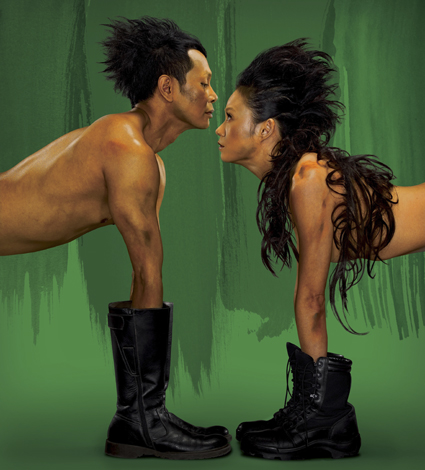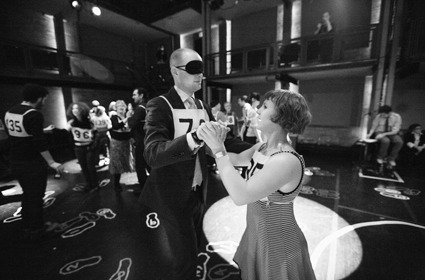the inventiveness of islands
keith gallasch: elizabeth walsh, ten days on the island

Animal Farm, Wild Rice
IN AN ERA OF INTERNATIONAL ARTS AND FILM FESTIVAL GIGANTISM, SMALL FESTIVALS HAVE TREMENDOUS COMMUNITY AND THEMATIC APPEAL, THE POTENTIAL FOR SHARED EXPERIENCE AND CLARITY OF PURPOSE. TEN DAYS ON THE ISLAND IS AN EXEMPLAR OF SUCH FESTIVALS. CURRENT ARTISTIC DIRECTOR ELIZABETH WALSH HAS BUILT SUBSTANTIALLY ON THE ORIGINAL THAT WAS MAGICALLY REALISED BY ROBYN ARCHER, THE FIRST ARTISTIC DIRECTOR OF TEN DAYS ON THE ISLAND (FOR WHOM WALSH WAS PROGRAM MANAGER, 2001, AND EXECUTIVE PRODUCER, 2002- 2005). I SPOKE WITH WALSH ABOUT HER FORTHCOMING THIRD AND FINAL FESTIVAL.
The festival has embraced more and more Tasmanian communities every two years, more island cultures around the world and tackled the very idea of ‘islandness.’ What’s been the focus of your approach?
What I really wanted to do with the 2011 festival was to get artists to engage for longer out in the community. So there’s a whole range of residencies all over the state. Theatre Newfoundland Labrador Youth Theatre is making work here with Launceston’s Second Storey. Melbourne’s Chamber Made Opera will be on Bruny Island [with Minotaur—The Island, a ‘reconstruction’ of a lost Monteverdi opera] and The Gertrude Association, also from Melbourne, will work with the King Island Cultural Centre [in a new media residency with an installation and workshops]. It’s about engagement between artists in communities that aren’t urban-centric—the festival itself isn’t urban-centric. It’s all over Tasmania allowing people out there to have the one-on-one experience of meeting an artist. This development over these three festivals has been the thing I find the most satisfying. It really changes the way in which people approach the festival—being more than just an audience.
How do these meetings work?
Often around projects or ideas that engage Tasmanian companies and artists through commissions which, where possible, have a broader creative presence than just providing performances. I’ve developed collaborations over these three festivals between young people passionate about music and professional music groups. There was the Tasmanian Youth Orchestra and the Strung Out Project in 2007, then access was provided for TYO in 2009 to Ethel [a string quartet from Manhattan] and in 2011 there’s a collaboration between the Australian Youth Orchestra’s Wind Quartet and the Tasmanian Youth Orchestra along with tutoring by the principal oboist of the Tasmanian Symphony Orchestra—potentially changing the creative output of younger artists.
Continuity’s important for you?
It’s like a longer conversation and finding new ways to develop it. It’s not just a flash in the pan.
The festival’s geographical scope seems to broaden each time too. How many towns did you ‘inherit’?
In 2001, for the first festival Anthony Steel’s report recommended eight and I think with Robyn Archer we actually did 32; 2007 was 52, last festival was 56 and this time round we’re going to 62.
They’re all willing partners?
(LAUGHS) Absolutely. If we didn’t go to certain areas, I’d be lynched. It’s one island and there are only half a million people here but the communities are very different in terms of their interests. It takes one good music teacher and suddenly you have an interest in string playing. It takes one person who’s interested in dance to wind up at a school like St Helen’s or someone with a passion for the visual arts, like Sally Marsden on King Island, and suddenly you’re able to not only support what they’re doing but also build opportunities in the community.
I don’t like using the term “community development,” because I don’t think that’s what it’s about. A lot of my work has been around putting artists in environments where they have opportunities to work in different ways in terms of situating their work. So Chamber Made Opera is going to a little hall on the end of Dennes Point on Bruny Island. I haven’t asked them to make work in a different way; I haven’t set up an environment where they’re necessarily going to change the creative experience that they’re engaged with. But certainly being there will change things—buying a loaf of bread at the local shop will change their own and locals’ experience. It’s about putting artists into different environments, changing not only them but the environment they’re in. If the world were full of more of those experiences, we’d be a better place. People take up the opportunity to meet and engage with artists like Ross Bolleter (RT91, p14) collecting old pianos on and off for three months for his work Ruined for the 2009 festival. How often do you get to meet a composer? It opens up the work to a broader audience and, I hope, people’s imaginations and inquisitiveness.
So, sometimes the artist might be working directly with people, sometimes it’s just being there that’s critical?
I’d like to think that Ten Days is not just a ticket price. It’s about evolving a whole range of different entry points for people, providing commissions that are the beginnings of conversations for artists and audiences and contributing to the broader sense of identity of this place. There have been particular projects that have been very important in this respect.
The Port Arthur Project [see rt review] in 2007 involved 27 commissions at Port Arthur with the University of Tasmania and Port Arthur as partners. In 2009 it was Trust, where we worked with the National Trust and, again, the university on commissions in five National Trust properties. And this time round we’re working on site-specific installations with the NRM North [Natural Resource Management Group] in the northern part of the state in five locations that are as diverse as a field, a community hall and a restaurant. The interest here has been about developing a conversation around built and natural heritage. We have so much built heritage here—that kind of “Georgian-ness” of the place. But my exploration’s been more about how contemporary Tasmanians articulate that history in a way that’s for now. Not that I’m saying don’t restore those beautiful homes or don’t touch the wilderness but, rather, how do we view these as they’re presented to us—for example as images for tourism.
Has the concept of a festival of island cultures from around the world evolved over the years?
It’s a fabulous idea. The genius of Archer, picking on the thing that seemed to be a disadvantage! Often small islands off continents—like Newfoundland and New Zealand—are the brunt of jokes, seen as backward and behind. What’s been interesting in the conversation generated by Ten Days on the Island is that it hasn’t been filtered through the main cultural hubs of the world. Not everything has to have been through New York or be the biggest thing or part of the star system that operates within more urban festivals. It liberates you to go out and really have a look at what people are doing in other places. Once upon a time would a show like Vestuport’s Metamorphosis for the 2009 festival have ever come to Tasmania? And that came from digging around in Iceland!
There are also links with international academic Island Studies about island dwellers experiencing not the same but very similar things: in the leaving of islands, in notions of the sea, in politics determined by the size of a place—Ivan Heng’s work from Singapore is significant here.
I see also there’s a Korean work for young people—Halmang, Myth of Jeju Island—about the mythology associated with an island off Korea.
And it’s been fascinating to find all that reggae material in the Pacific [Pacific Reggae: Roots Beyond the Reef]—an extraordinary kind of movement. So it’s not just islands or one kind of idea—the festival teases out a whole range of different kinds of connections that aren’t necessarily obvious. That’s the great thing for me as an artistic director—having several festivals gives you time to go digging and find those things that are not just literally the obvious connection.

Dance Matathon, bluemouth inc
photo Gordon Hawkins
Dance Matathon, bluemouth inc
Are there shows that will particularly appeal to RealTime readers?
Dance Marathon by bluemouth inc (Manhattan-Toronto) represents the evolution of a particular kind of theatre form. Dancing, moving, having a partner and the dance marathon premise of the film They Shoot Horses Don’t They, these are the mechanisms through which the company explores a different kind of relationship between performer and audience. It’s fascinating.
Orwell’s Animal Farm, as adapted by Ivan Heng for Singapore’s Wild Rice, is an extraordinarily well-made piece of theatre in which the actors play the animals, transforming into them onstage. The dogs are fantastic: they’re just stupid. The show’s quite fantastic.
Daniel Barrow’s Every Time I See A Picture I Cry just won the Scobie Award for contemporary art in Halifax, Canada. Daniel works with layers of acetate on which he has illustrated the world of the narrative he’s about to tell. He manipulates the acetate using an overhead projector to animate the story. It’s exquisite. Right out there. It’s about a janitor sifting through the city’s garbage in order to create a phone book and a chronicle of the life of every citizen in the town. At the same time he’s being stalked by a serial killer. Another fascinating work and an exploration of a different form altogether.
Chronicles of Long Kesh, a theatre work from Belfast’s Green Shoot Productions, uses documentary style interviews as its basis. It’s tough material—we’re talking about the blanket protests and Bobbie Sands starving himself to death—and it’s hard to perform. But the structure comprises 10 or 15-minute vignettes, some only two minutes. These are interspersed with the songs the prisoners in The Maze used to sing to each other. One of the IRA guys was a choirmaster. Interestingly, it’s another story of an island—The Maze. Could that have happened in another place, that story? Guantanamo Bay is an island. When I saw the show, I couldn’t speak for half an hour afterwards. We know something of the story and ‘The Troubles’ but it’s something else to be in the dark with a great piece of theatre.
The 2011 festival program looks very good—ample shows, diversity of practice, location and invention.
The scale of our program is small, our budget is tiny. Maybe Darwin is smaller. But I look at the program and think, actually this is good—all sorts of ideas and experiences across the island. A lot of it’s about working partnerships. It’s great that after three festivals I can leave and think, We did good here.
Festival-goers should also look out for Stompin’s I ♥ Cars; Erth’s Dinosaur Petting Zoo; Djupid (The Deep) from Iceland and Scotland; version 1.0’s Bougainville Photoplay Project; Terrapin Puppet Theatre’s Australia-China collaboration, When the Pictures Came; New Zealand String Quartet; Craig Walsh’s Digital Odyssey; Julie Gough’s The Crossing; Ming Wong’s Life of Imitation, about the golden age of Singaporean cinema; Puso, by Philipino artist Richie Ares Doña; and Welsh visual artists Heather and Ivan Morrison working with locals, puppets and an old truck in Mister Clevver.
Ten Days on the Island, Tasmania, March 25-April 3, www.tendaysontheisland.com
RealTime issue #101 Feb-March 2011 pg. 25






